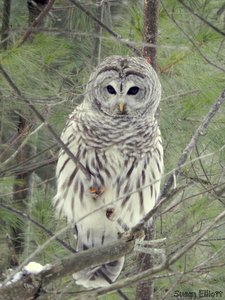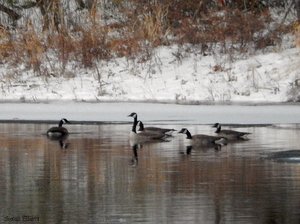
Recognition and credit is due to the 22 dedicated field observers and eight faithful home feeder watchers who participated. Two dozen participants rallied later in the evening at the Proctor Free Library for a pot-luck supper and count down. To the four team members from outside Rutland County who joined the local teams, thank you for your enthusiasm and contributions.
Weather conditions were mostly favorable with partly cloudy skies in the morning becoming more intense in the afternoon while a biting westerly wind at times gusted up to 15 mph. Temperatures for most of the day were above freezing and remained in the 30° to 38° range. Small ponds were frozen but streams were open, a contributing factor to the record number of Belted Kingfisher tallied. Snow cover varied from open ground to approximately 4 inches. Roads were clear, well sanded and drivable, an important consideration with the field teams covering 386.5 miles by car.
With 8,674 individual birds counted the number was within 2% of the ten year running average of 8832. The species count of 51 closely reflected the ten-year running average of 51.2.
In spite of the apparent ordinariness of the above numbers several records were established. The sighting of a single Bald Eagle and three Rough-legged Hawks matched previous records for the species. A Red-tailed Hawk count of 42 exceeded the previous record of 37 established 15 years previously. For many years only a single Peregrine Falcon had been sighted, now the record is two. It was a good year for Belted Kingfisher with a tally of six. The previous record of four goes back 25 years. The Carolina Wren total of 16 birds increased the record by one.

Count Numbers:
Canada Goose (705), American Black Duck (43), Mallard (74), Common Merganser (4), Bald Eagle (1), Sharp-shinned Hawk (1), Cooper’s Hawk (5), Red-tailed Hawk (42), Rough-legged Hawk (3), Peregrine Falcon (2), Ruffed Grouse (2), Wild Turkey (30), Rock Pigeon (609), Mourning Dove, (388), Barred Owl (1), Belted Kingfisher (6), Red-bellied Woodpecker (4), Downy Woodpecker (57), Hairy Woodpecker (32), Pileated Woodpecker (8), Horned Lark (10), Blue Jay (359), American Crow (1045), Common Raven (18), Black-capped Chickadee (858), Tufted Titmouse (67), Red-breasted Nuthatch (16),
White-breasted Nuthatch (78), Brown Creeper (7), Carolina Wren (16), Winter Wren (2), Golden-crowned Kinglet (13), Eastern Bluebird (25), Hermit Thrush* (2), American Robin (60), Cedar Waxwing (511), Northern Shrike (1), European Starling (1956), Northern Cardinal (110), American Tree Sparrow (237), Song Sparrow (4), White-throated Sparrow (20), Dark-eyed Junco (263), Snow Bunting (3), Red-winged Blackbird (4), Rusty Blackbird (10), Brown-headed Cowbird (4), Purple Finch (8), House Finch (68), American Goldfinch (475), House Sparrow (307).
Bold → Record Number * New Species to the count.